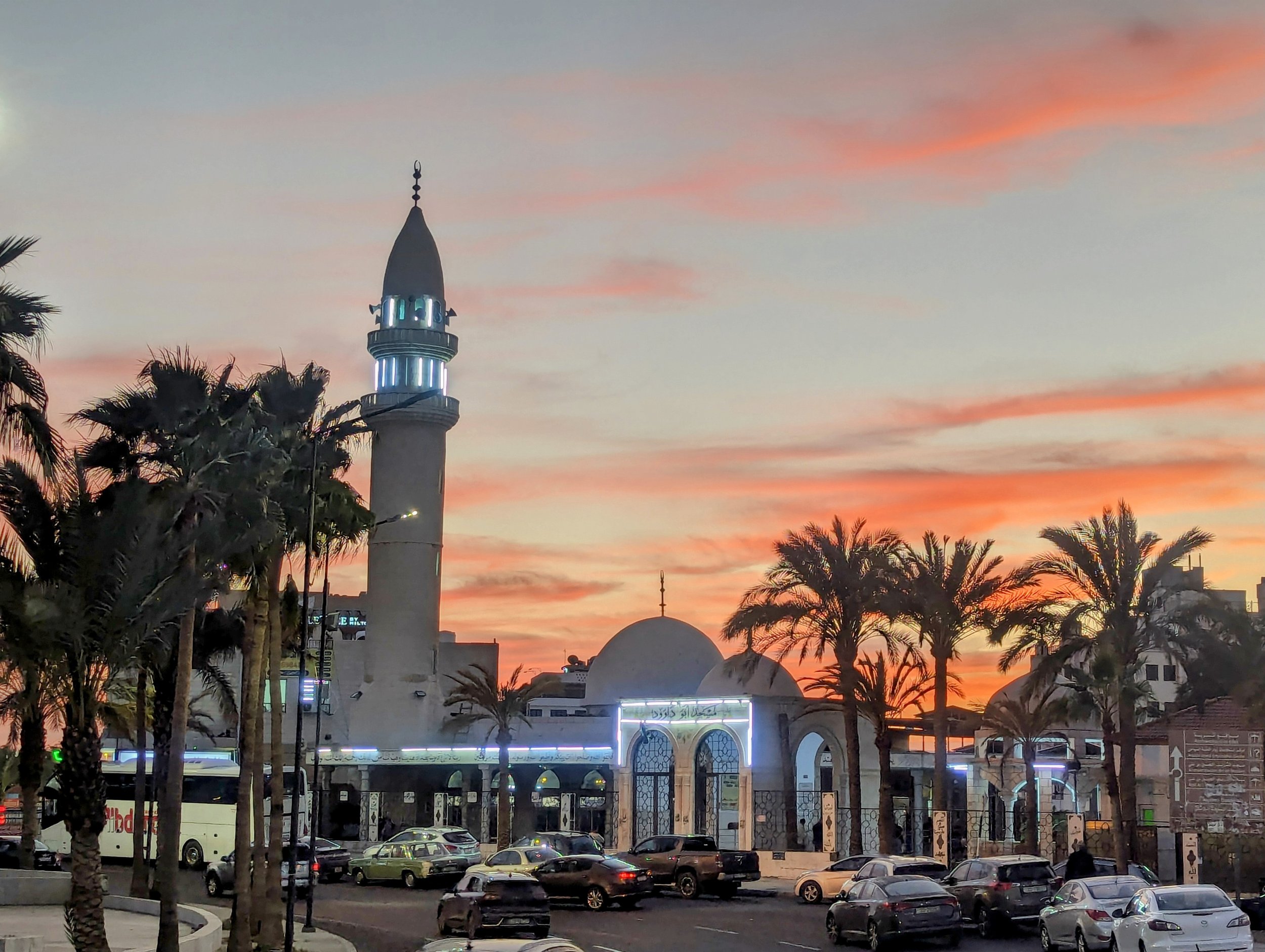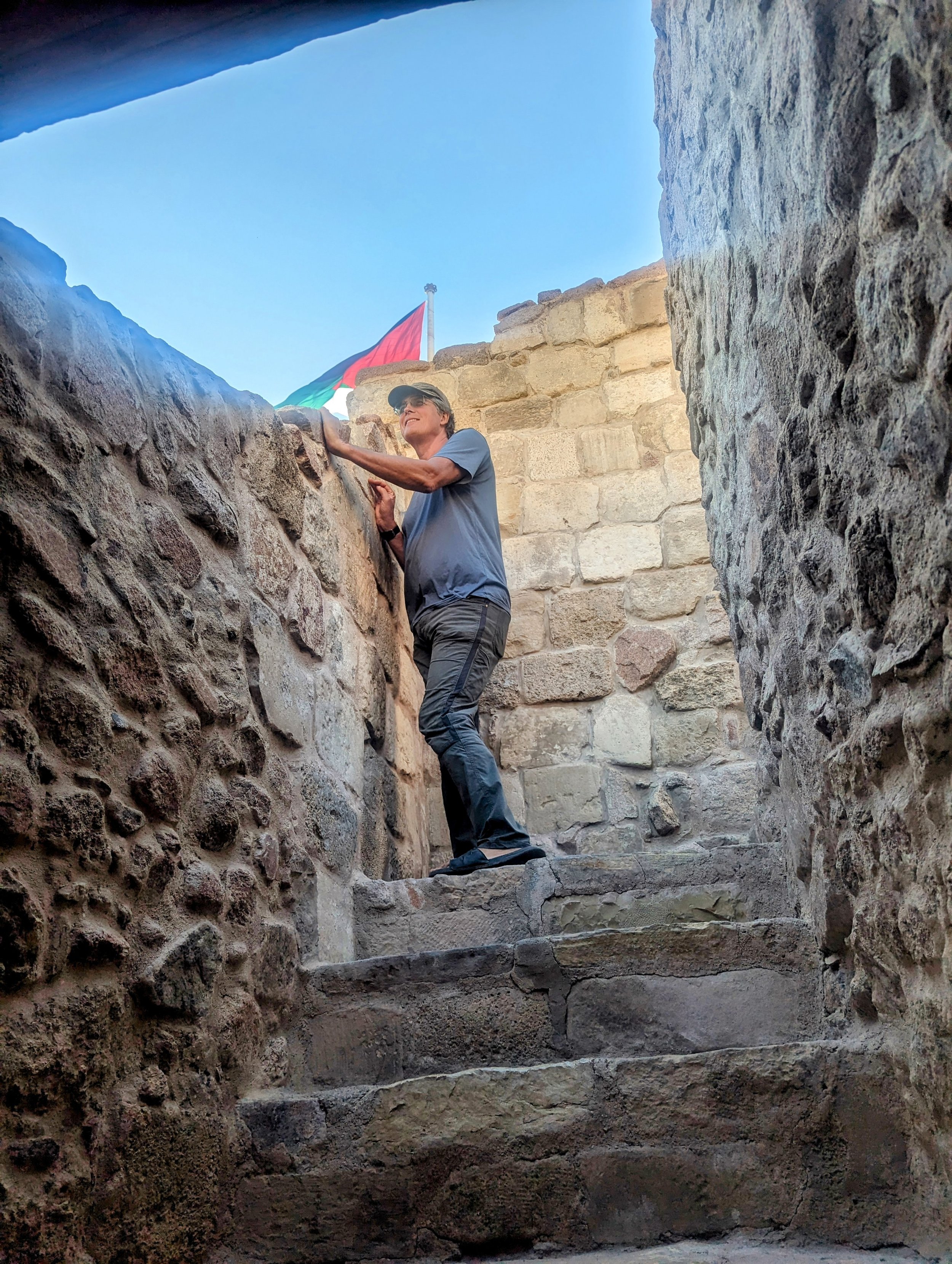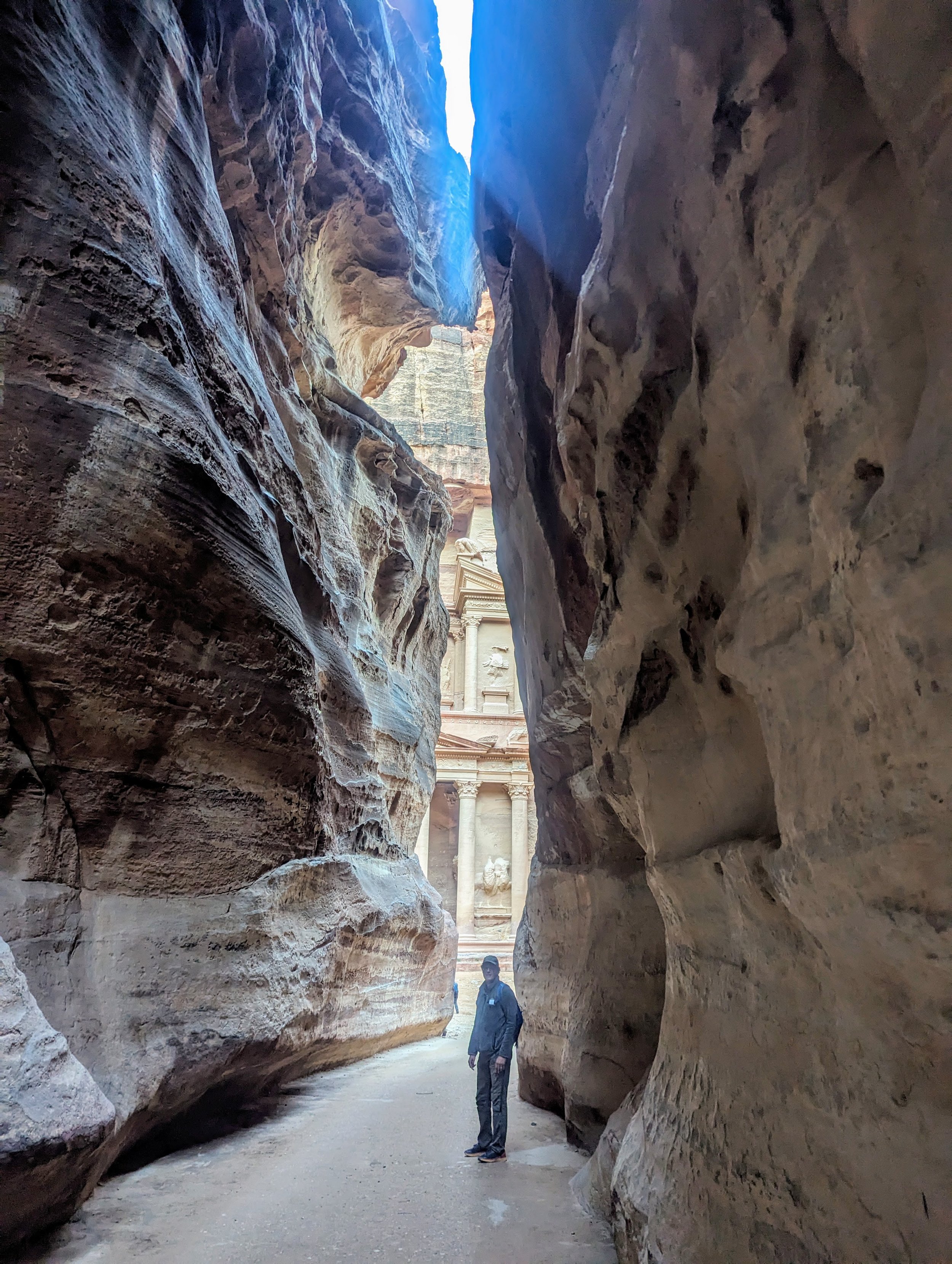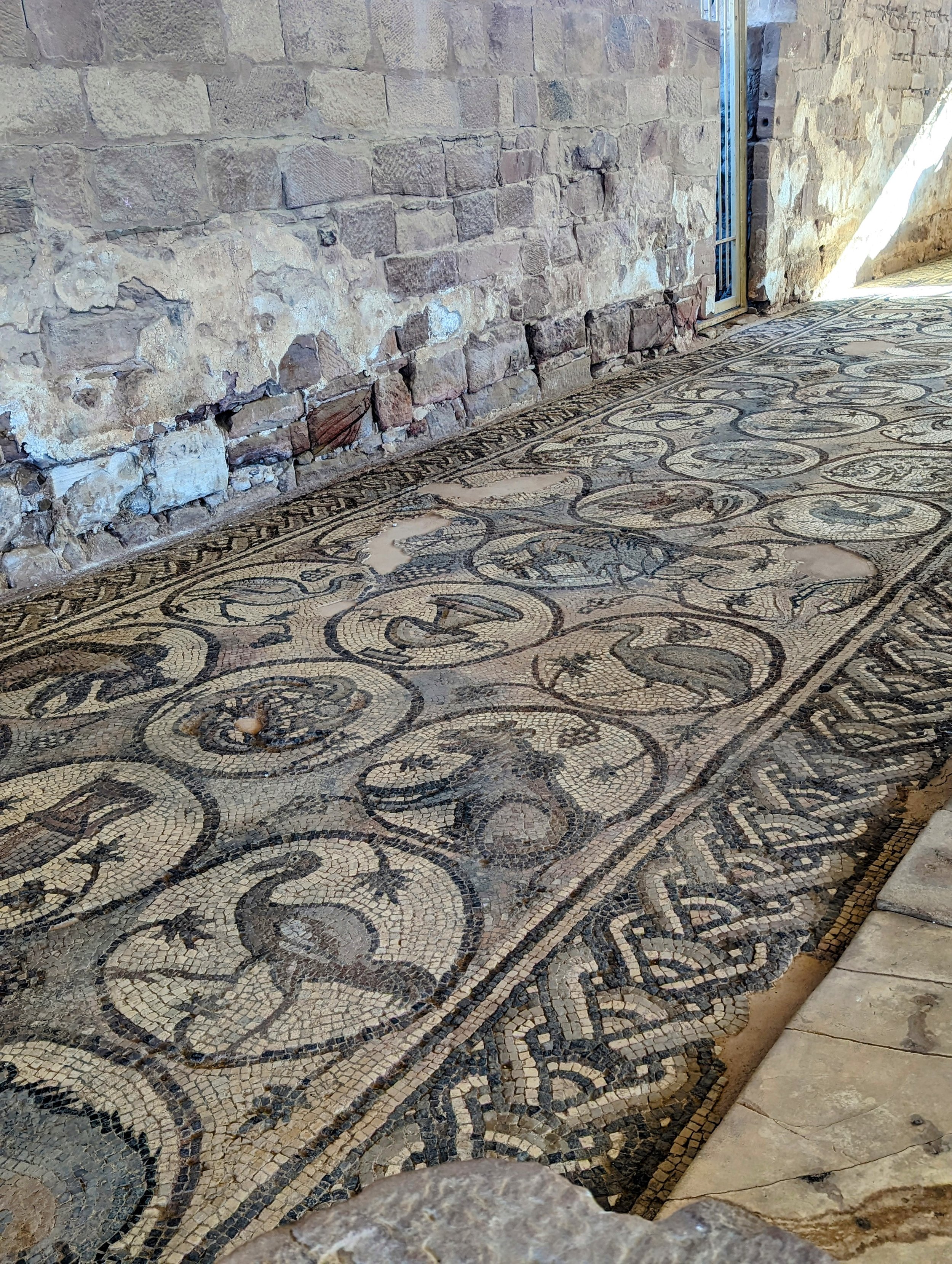Jordan
“The Monastery” at Petra
Jordan quickly became one of our top travel destinations. Exploring beautiful deserts, wadis, and majestic ruins of ancient civilizations made for a delightful blend of experiences.
For us, being from the western United States, entering Jordan also brought a welcome sense of relaxation and comfort. The strict cultural mores of Saudi Arabia that we had been highly aware of and affected our interactions with people, evaporated. Still a Muslim country, Jordan wrote religious freedom into their constitution in 1952. This plus a long standing pursuit of international tourism made the country feel more relaxed for non-Muslim visitors. We had not realized how much background stress we had been carrying in Saudi Arabia until it disappeared. There was a mix in how people dressed, some women in traditional abayas, others in jeans. We kept to our modest dress code and felt completely comfortable.
Our two week, 700 mile route through Jordan and into Israel
As with other countries in the Middle East, we felt safe and basic necessities were easy to find. People embrace, understand and welcome the desire to be outdoors and camp. Tourism was down when we were there, visitors were avoiding the area because of the war with Israel and Hamas. This meant we stuck out, but were warmly greeted with teenagers running up to us on the street asking where we were from and looking for opportunities to practice English.
View from our hotel window out on Aqaba as the sun goes down
We entered at the border near Aqaba, an attractive coastal city on the Red Sea known as a scuba diving and beach vacation destination. The border crossing was uncomplicated. We had opted to purchase the Jordan Pass, an all inclusive ticket for Jordan’s natural parks and cultural attractions and which also waived the visa fee. (We purchased the least expensive passes at $100 which included one day’s admission to Petra.) Our only costs at the border were purchasing required national auto insurance (expensive at $140) and $28 for bringing our own vehicle in (or road tax? we were not quite sure). Arriving in Aqaba, we opted for a hotel night and set out to walk the city.
Ruins of Ayla, the first Islamic City built off the edge of the Arabian Peninsula, dating back to 650 AD
Beautiful Sharif Hussein Bin Ali Mosque
Sunset over the minarets and palm trees. In Jordan we continued to appreciate and admire the traditional Islamic architecture.
In Jordan, we also had some of our favorite MIddle Eastern food. Aqaba was full of contemporary, inexpensive, local food cafes. Pictured here, delicious Manakeesh, local flat bread served with a variety of toppings, reminiscent of designer pizza.
Exploring Mamluk rebuilt by the Mamluk dynasty in the 1500s. It was pivotal in the Arab Revolt against the Ottoman Empire in 1917.
And then, always a highlight for us we spent a day scuba diving in the Red Sea. The previous king of Jordan, King Abdullah II had been a diver and made sure that several multiple wrecks were sunk off the coast. This made for interesting diving, not only the wrecks themselves but the habitat they create for wildlife. We did the best known dive in the area, Cedar Pride, a freighter which had been sunk in 1985. The wreck dives in the marine reserve were shore dives which made it easy.
Andy heading in for a dive, photo bomb courtesy of a fellow diver from Qatar.
Our excellent divemaster, former navy diver Abdusalam
After diving we stocked up on supplies in the city and prepared to set off on the road.
Fresh pita bread off the assembly line - amazing, our favorite with the local hummus, also nothing like what you buy in the US.
Stocking up at the Carrefour - French supermarket chain found throughout the Arabian Peninsula - we would seek them out when we really wanted a baguette (yes we loved the local pita bread but sometimes we just wanted a baguette).
We took care of business, filling up with groceries, gas and water and headed out to the beach for a night of camping in the Aqaba area.
The two busloads of kids who arrived at 11pm to join our solitary beach camp
It was one of our surreal camping experiences (similar to Jebel Jais in the United Arab Emirates when we were joined by a huge gathering of men at midnight). This time, we were set up alone on the beach and preparing dinner when three trucks full of poles and canvas drove up. We watched as about 10 men set about erecting a huge tent over the course of two hours. They finished about 10 pm, and we assumed there was an event happening in the next few days. We should have known better. At 11pm two huge buses pulled up and unloaded singing youths carrying their bedrolls to the tents accompanied by marching drummers. We had learned not to try to tough it through situations like this so popped down, left the happy young beach campers behind and moved ourselves down the beach to quiet. We were guessing they were a school group on vacation or on their way to Mecca.
Maybe not our most restful night, but you take what you can get when you are camping for free on public land. The next morning we were off to one of our favorite places in Jordan - Wadi Rum.
Exploring the cliffs at Wadi Rum
Wadi Rum Reserve encompasses 280 square miles of colorful, varied and fascinating desert landscapes. With rock formations, narrow gorges, sand dunes it was a natural wonderland to explore. And of course, in a country so steeped in ancient human history, it also had cultural sites.
One of our first stops was the “Lawrence of Arabia” house used by TE Lawrence as a hideout when he was fighting alongside Arabians in their war with the Ottomans in 1917. The site itself predates Lawrence’s stay with evidence of 2000 years of occupation.
The whole Lawrence of Arabia story was a fascinating study in how ethnocentric our education can be. Our hazy memory of him was that we was a famous and heroic fighter. In fact he was a British archeologist who became enamored of all things Arabian and was instrumental in introducing the culture to the British world through his writing. He fought alongside Arab forces in the Arab Revolt. But your average Jordanian has never heard of him, he did not figure at all in their hero stories of the war.
Stopped by Lawrence of Arabia’s hideout
Camped against the cliffs at Wadi Rum
Roads were inaccurately mapped and rough, but that made the adventure even better. We saw few other people but were surprised by the number of empty camps set up Bedouin style for tourists. We guessed that when it is busy the area is hopping with people coming to experience the desert Bedouin style.
Beautiful valleys to explore - all off road driving
Exploring narrow canyons with rock carvings
Then from Wadi Rum, we made our way to Petra, an iconic bucket list place for us to visit. We pulled into the free parking lot adjacent to the visitor center and set our alarm to get up at the crack of dawn for an early entry.
Popped up and camping outside the Petra visitor center
Petra is one of the most amazing archeological sites in the world. The whole experience was magical. With our one day of admission, we made the most of it, walking 12 miles, climbing 1000 steps up to and back down from The Monastery and wending our way among and over cliffs to find “hidden” carvings (with the lack of people we had the incredible experience of being the only ones at many of the more remote sites).
Entry road to Petra at 6am
The first rock carving you come to as you enter Petra “Obelisk Tomb”
Built by the Nabataeans, an ancient Arabian people, most of the carvings in the rock faces date back to the 1st century AD and were intended as decoration for tombs for their kings.
Entrance to Petra is a 1.2 km narrow canyon walk (called the Siq)
Our first peek through the canyon of one of the most famous carvings “The Treasury”
“The Treasury” carved out of the rock cliff
Not being early morning people, the 6am start was a push for us. But standing before the glory of these monuments as one of few visitors made it all worthwhile. There were more staff than visitors when we were there. It was a difficult time for tourism in Jordan and small business owners were suffering. We had empathy for them but were also enormously grateful to be at Petra at a time no one else was.
Poking in and out of tombs along the way
Making our way along the “Street of Facades”
Carvings in the rock everywhere we looked
Camels available for hire for tired walkers
“The Theatre”
“The Palace Tomb”
We are probably including too many pictures, but we could just not stop gasping at the wonder of it all. Photos may be worth a 1000 words, but we still felt like even the photos cannot capture the scale and artistry of Petra. It was also extraordinary to be able to explore freely, climbing up to examine the carvings, being able to see the actual chisel marks and even the hand holds made for the talented climbers to get to the top to complete their work. We felt strangely honored and respected for the trust put in us not to harm or damage any of these ancient monuments (which of course we would never do).
Mosaic floor of a Byzantine Church
Intricate carvings everywhere you looked
The Great Temple of Petra
So little is known about these ancient Nabataean Arabian people, but that allows for your imagination to go wild as you wander their ancient city.
Climbing the 1000 steps to the Monastery
As the day wore on we did see more visitors. It was a little disconcerting to pop out at the top by the Monastery and see van loads of tourists. There is a secondary entrance at this side of Petra and you can opt to enter here and walk your way down the steps, through the valley and out past the Treasury to the visitor’s center. This is a great option if you do not want to end your day completely worn out and exhausted as we did (but we were also happy and satiated).
After leaving the Monastery we returned on one last trail which took us off on our own again and felt mystical. The Wadi Farasah Trail winds you among intricately carved cliffs and eventually up to the HIgh Place of Sacrifice.
Inside one of the smaller tombs
Petra is not flat!
Garden Temple along the Wadi Farasah Trail
Its 4pm now, getting a little slower on the steps
View from the “High Place of Sacrifice” a name which heightens curiosity and imagination
Dawn taking a break, refusing to walk for 10 minutes
There are many ways to tackle Petra, in retrospect, maybe we should have taken a taxi to the entrance by the Monastery and walked one way back through the whole valley to the main entrance. Or we could have purchased the two day pass and split up sections. But in the end we were thrilled with our long and tiring day and loved all our side ventures on trails that led out of the main valley floor. Somehow taking it all in at once made the experience huger and even more impressive. We left feeling awestruck and not sure what else Jordan could offer up to compare. But of course the dramatic scenery and history continued.
Wild camp along the way at Wadi Ghwayr
Similar to surrounding countries, Jordan had abundant scenic wild camping, we could always find a remote and beautiful spot.
Learned to watch out for these guys hiding under rocks, venomous but not deadly (at least almost never).
Continuing our cultural exploration, our next stop was Shobak Castle, a crusader castle built in 1115. It was a fascinating ruin, but there was very little information to give us cultural context so we wandered around ignorantly for a bit then continued on our journey.
We learned to find and appreciate architectural details like this Arabic writing on the tower at Shobat Castle
The scenery was spectacular in Jordan, even when we were not expecting it we would turn a corner, and see great beauty.
Looking down on Dana Biosphere. Israel in the far distance
Stopping for a ramble around the old village of Dana
More sheep than people
Exploring wadis continued to be one of our favorite experiences and we found this next one on our way to the Dead Sea. There was a Bedouin camp near the entrance so we decided to see if we could camp inside the canyon, away from people. After investigating on foot and checking the weather report for the whole watershed, (wadi camping is not recommended if rain is expected due to flash floods) we decided to venture in.
Pre-walking Wadi Numeira to see if we can drive in to camp
Driving the truck in, definitely not sleeping under that overhanging rock
Beautiful camp and Andy taking advantage of natural rock formations to wash the solar panels on top
Our next castle visit, Kerak Castle, was much more extensive and impressive than Shobak, but also more visited. Another crusader castle, Kerak fell to Saladin and his Muslim armies in 1188 and later was taken over by the Ottomans - a varied and storied history.
Drawbridge to Kerak Castle
Intricately carved stone
View over the vast Kerak Castle and surrounding city
Endless underground tunnels
And then, finally the Dead Sea! Another bucket list moment.
Posting the truck at our first view of the Dead Sea
Beautiful colors and patterns along the coast
Beach access along the Dead Sea can be difficult - a lot of it is privately held so we opted to make it easy on ourselves and stay in a hotel which guaranteed access to a private beach.
In our years of travels we are always deeply grateful for resources provided in English. However, there have also been moments of hilarity as translations can sometimes go wrong. We did not use this hotel laundry service but were glad to know that if we did our clothes would be returned clean and with a dry sense of humor.
Bobbing like corks, feet up in the Dead Sea
Andy opted out of the hotel spa experience for his very own “do it yourself” Dead Sea mud bath
Next on our route, the ancient city of Madaba. Known for its mosaics from throughout the ages and religions (Hellenistic, Byzantine, Roman, Islamic) it was another journey through history.
Visiting ancient mosaic sites in Madaba
One of the most famous mosaics, a 6th century map
Walking the ancient Roman road
Despite not always loving big cities, we decided it was important to visit Amman and were pleasantly surprised. Not only was the food excellent (and cheap! but then we were basically eating street food) but the city was lively and interesting, a blend of cultures and histories with souqs side by side with Roman ruins.
Waiting for shawarma (grilled meat wrapped in pita bread - $1)
Best falafal we have ever had (also $1)
Dawn is really happy with this falafel from Al Quds in Amman
King Abdullah Mosque in Amman
Looking down on Amman from a hill top - a sea of buildings
Roman ruins in the center of Amman
We had some interesting conversations with Jordanians in Amman. We got the sense there is some concern over the growing number of immigrants (primarily from Syria and Palestine, combined percentage now up to about 30%) who are entering the country and becoming citizens. Although they are often successful in their careers, Jordanians who trace their roots back to Bedouin times worry that the country is losing the roots of their culture and also they are not being prioritized by the government for services and support. We only scratched at the surface of this interesting and international issue but it was fascinating to hear the different perspectives.
Hashemite Plaza in Amman - a gathering place for families with an old Roman theatre as a backdrop. Named after the Jordanian royal family. (The full official name of the country is the Hashemite Kingdom of Jordan)
Our next stop in Jordan was what is probably the second most famous cultural site - Jerash - with some of the best preserved Roman and Byzantine ruins in the world. A prosperous trading center, Jerash featured temples to the great gods Zeus, Hera, Apollo and Poseidon as well as stunning entrance gates, theatres and open market areas. It was another history rich day and once again we were selfishly grateful for the lack of fellow tourists.
South Gate entrance - Arch of Hadrian built to honor the visit of the emperor in 129.
Central plaza surrounded by columns
Colonnaded street
Walking towards the North Gate
We left Jerash ready for some more wild camping and Andy always loves a forest so we headed for nearby Dibbeen Forest Reserve. We forgot to take into account that it was Saturday. We have never seen such a crowded forest in our lives. Every nook and cranny was filled with cars full of families having sunset picnics. The only downside to a culture that embraces the outdoors is sometimes it can get crowded. We checked a few more places in the area, started getting concerned but then at dark pulled into a beautiful site in the Aljoun forest - one of our favorite fall backs, camping at a trail head.
Wild camping at the edge of Aljoun Forest
With a bonus hike the next morning - Andy appreciating the wild flowers, definitely did not feel like we were in the Middle East.
Even this area was filled with arch sites - like this old quarry
Then with our time in Jordan coming to and end, we made one more castle stop at Aljoun castle - a fascinating and well preserved and renovated site dating back to the 12th century Muslim world.
And that was Jordan! As we explained on our shipping Israel to Greece blog, we made the decision to drive from the Jordanian border to Haifa and ship the truck to Greece to continue our journey east through Turkey, Georgia and eastwards. Our time in Israel was very brief as the country was under a lot of stress. We plan to return some day and really visit.
Enjoying the view in Jordan
The Arabian Peninsula was a fascinating journey for us, many more ups than downs and overall an enriching experience. We look forward to a brief return to Europe in Greece then exploring the Caucuses and the Stans as we head east. Thank you for travelling along with us and reading our blog!




























































































